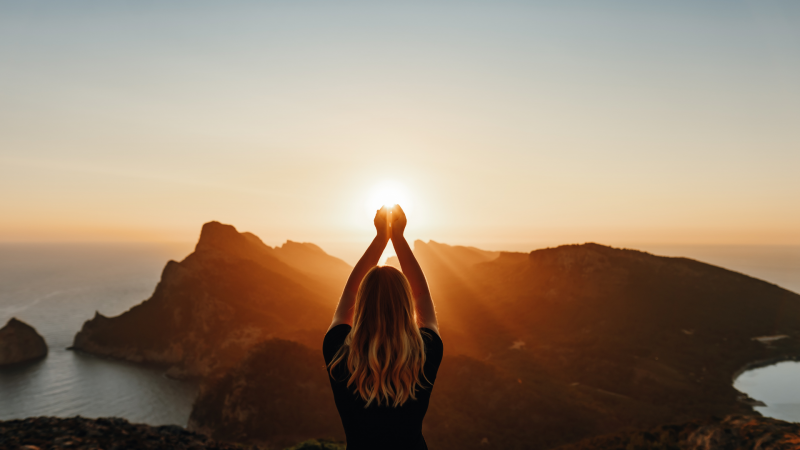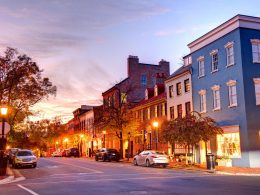There are many sacred places around the country. Some are relatively new religious buildings; others are areas of land with thousands of years of history. No matter what you believe or practice, it’s critical that you conduct yourself with reverence and respect in these locations. We’ve found some of the most sacred places in America that we want to share with you.
Today, we’re looking at 10 of the most sacred places in America and why you should consider visiting them. Let’s dive in!

What Does It Mean for a Place to be Sacred?
Sacred places are often held in high regard and considered holy or deserving of reverence and respect by people who hold certain beliefs or traditions. This is often due to religious, cultural, or historical significance and has connections with spiritual beliefs and practices.
Some examples of sacred places include temples, churches, shrines, and natural sites. Just because a place doesn’t look or feel sacred to you doesn’t mean it’s not to someone else.
HOT TIP
Dive deeper into spirituality by attending one of these 5 Best-Rated Ayahuasca Retreats In America.
Why Visit a Sacred Place?
Visiting a sacred place can be an incredibly powerful experience. People often visit these places for a variety of reasons. You can visit a sacred place for religious or spiritual fulfillment, cultural or historical significance, or personal growth. In addition, many people visit these locations to connect with the surrounding community or nature.
In many cultures, visiting sacred places is a way to honor ancestors and uphold their traditions and beliefs. That can reinforce cultural and religious traditions and pass them on to future generations.

10 Most Sacred Places in America
Whether you’re religious or enjoy learning about other cultures, we’ve found 10 of the most sacred places in America. Let’s take a look at some spots you should visit.
1. Bighorn Medicine Wheel
Location: Lovell, Wyoming
About: The Bighorn Medicine Wheel, also known as the Bighorn Medicine Wheel National Historic Landmark, is a Native American sacred site located in the Bighorn National Forest in northern Wyoming. The site consists of a circular arrangement of stones believed to have been built by indigenous peoples, likely the Plains tribes, between 1000 and 1700 AD.
The exact purpose of the Bighorn Medicine Wheel is unknown. Many believe it served as a spiritual or religious function. It possibly served as a site for astronomical observations, rituals, or as a wayfinding marker for tribal travelers. The wheel is composed of a central cairn surrounded by 28 spokes that radiate outwards, forming a circle with a diameter of approximately 80 feet.
Why It’s Sacred: Not only do many consider it sacred, but it’s also an important cultural resource. It’s a national historic landmark, and visitors should treat it respectfully and avoid altering or removing stones.
Despite its subjection to centuries of weather and natural erosion, the Bighorn Medicine Wheel remains an impressive and fascinating example of Native American sacred architecture.
2. Devils Tower
Location: Devils Tower, Wyoming
About: Devils Tower is a volcanic rock formation in northeastern Wyoming. It’s a popular destination for rock climbers, photographers, and nature lovers. In 1906, it was the first United States national monument, established by President Theodore Roosevelt.
The tower is solid magma that rose from the Earth’s mantle. Over time, erosion has worn away the surrounding rock, leaving behind the towering monolith that stands today.
It gained tremendous popularity due to Steven Spielberg’s 1977 blockbuster movie, “Close Encounters of the Third Kind.” A local campground plays the movie for guests each night so they can watch it with the rock formation in the background.
Why It’s Sacred: It’s a sacred location for many Northern Plains Native American tribes, such as the Lakota, Cheyenne, and Kiowa. These tribes have cultural and spiritual connections to the site. The tower holds spiritual significance, and many believe it to be a place of prayer and vision quests.
It’s also associated with various creation stories and is said to have formed through the actions of supernatural beings. These beliefs and stories have been passed down through generations, making Devils Tower a revered site for Native American communities. Religious ceremonies occur at the location to this day.
3. Salt Lake Temple
Location: Salt Lake City, Utah
About: The Salt Lake Temple is a temple of The Church of Jesus Christ of Latter-day Saints (LDS Church) in Salt Lake City, Utah. It was completed in 1893 and is the largest temple of the LDS Church.
It’s a massive granite structure with six spires and was constructed in a neo-gothic style. It took nearly 40 years to build and directly resulted from the pioneers sacrificing their time and material goods.
Why It’s Sacred: The Salt Lake Temple temple is the centerpiece of the Salt Lake City area and symbolizes the Mormon pioneer heritage. It’s a popular tourist destination and is open to members of the LDS Church for religious worship and ceremonies. While the temple’s exterior is open to the public, only members in good standing with the LDS church can enter the temple.
HOT TIP
While exploring Salt Lake, treat yourself to a drink from one of these Best Dirty Soda Shops in Salt Lake City, Utah.
4. The National Cathedral
Location: Washington, D.C.
About: The National Cathedral is the Washington National Cathedral in Washington, D.C., and the center of many religious and cultural events. It’s the sixth-largest cathedral in the world and is a notable landmark in the city.
The cathedral is an Episcopal church and has served as a house of worship for members of the Episcopal denomination and other Christians. It’s also a popular tourist destination, attracting visitors from all over the world to admire its architectural beauty and rich history.
Why It’s Sacred: Many view the Washington National Cathedral as sacred because it serves as a place of worship and a symbol of the nation’s spiritual life. It is a reverend space for members of the Episcopal denomination and other Christians to gather for worship services, sacraments, and other religious services.
Many see the cathedral as a symbol of national unity and a reminder of the role of spirituality in people’s lives. Additionally, many important events and ceremonies have taken place at the cathedral, such as presidential funerals and state events.
5. Bahá’í House of Worship
Location: Wilmette, Illinois
About: The Bahá’í House of Worship is a type of place of worship associated with the Bahá’í Faith. There are eight houses of worship structures in the world, with Wilmette, Illinois, being the first.
The worship spaces have distinctive, nine-sided architectural designs. The Bahá’í House of Worship is open to Baháʼís and non-Baháʼís. If you want to pray or reflect, this space allows you to do just that.
Why It’s Sacred: The Bahá’í House of Worship is a sacred space because it allows the community to come together for worship, meditation, and study. While many religions restrict guests to a specific belief system, the Bahá’í House of Worship welcomes all faiths, genders, and other distinctions.
6. Crater Lake
Location: Crater Lake, Oregon
About: Crater Lake is a large, deep lake located in the Cascade Mountains of southern Oregon. The lake is the result of a volcano collapsing thousands of years ago.
Today, the lake is known for its stunning blue color and crystal-clear waters, some of the purest in the world. Steep cliffs, which rise over 2,000 feet from the water’s surface, surround the lake. People know the lake to be the centerpiece of Crater Lake National Park.
Why It’s Sacred: For thousands of years, Native Americans have tied their hunting, berry gathering, and vision quests to Crater Lake. The area has a rich history with the tribes that call the area home, and many tribal legends revolve around the lake.
Tribal members who experienced a vision of supernatural beings living in the lake experienced an ultimate epiphany. Those who reside in the area today continue to treat it with respect and reverence.
7. Mount Shasta
Location: Shasta-Trinity National Forest, California
About: Mount Shasta sits on the southern end of the Cascade Range and reaches more than 14,000 feet. In addition to being a massive mountain, it’s also potentially an active volcano.
However, its last eruption occurred in 1250 AD, and there are no signs of that changing any time soon. The mountain is home to seven named glaciers and can be seen from over 140 miles away on a clear day.
Why It’s Sacred: The mountain is home to many stories, myths, and legends passed from generation to generation. Several tribes trace their roots back to the mountain, such as the Wintu Tribe. This particular tribe continues to gather at the streams of Mount Shasta in August for sacred ceremonies.
You don’t have to be religious to appreciate this area’s tranquility and natural beauty. Walking in the woods can provide the opportunity to connect with nature or your creator.
8. The Black Hills
Location: South Dakota, Wyoming, and Montana
About: The Black Hills are spread between South Dakota and Wyoming and have been a highly debated topic for more than 170 years. The United States government originally had no problems giving the natives 60 million acres.
Unfortunately, they changed their tune when there was suspicion that gold was on the land. For years settlers ignored the boundaries set by the treaty, and it wasn’t long before military posts began sprouting up.
A second treaty was later signed, which reduced the land to 20 million acres. However, with the confirmation of gold in the area, the US government pushed to capture all the lands. The Lakota have refused to accept any money for the land, as they state you can’t buy or sell sacred land.
Why It’s Sacred: The Black Hills are extremely sacred to the Great Sioux Nation. They view them as the birthplace of their Nation and where their people rose from the womb of Mother Earth. Much of the land that makes up many of the most popular tourist attractions in the Black Hills was prime land for the Sioux tribe.
9. Temple Emanu-El
Location: New York, New York
About: At 103 feet tall, 100 feet wide, and 175 long, Temple Emanu-El is one of the largest Jewish temples in the world. It has a seating capacity of approximately 2,500 people and has some of the most stunning architecture you’ll ever see.
The structure has more than 60 stained glass windows and numerous arches that contain mosaics of glass and marble. The building was constructed in 1929 and is also home to a museum that focuses on Jewish history.
Why It’s Sacred: The temple is a special place to those in the Jewish faith, whether they were born into the faith or joined by choice. They gather regularly and devote themselves to lifelong learning, social justice, and growing spiritually. You can feel a sense of sacredness when you walk through the doors.
10. The Islamic Center
Location: Washington, D.C.
About: The Islamic Center is one of the first mosques in the United States and was created in 1957. The temple was the site for George W. Bush’s reading of the Koran after the September 11th attacks. It’s more than just a mosque. It also houses a cultural center with a library and classrooms where individuals can take courses and learn the Arabic language.
Why It’s Sacred: The Islamic Center is a sacred mosque for those in the Islamic faith. It’s the center of their community and a place of prayer, school, political discussion, meditation, and religious instruction. Those in the Islamic faith hold it with great respect and reverence, and visitors to the mosque should too.
What to Remember When Visiting a Sacred Place
It may sound like common sense, but it’s important to remember you’re visiting a sacred place. As a result, you should conduct yourself with respect and reverence. Some of these places may restrict photography, video, or other activities. Make sure you are aware of what you can and can’t do.
It’s a good idea to observe those who appear to belong in the place. Observe how they conduct themselves and how they behave. A site may expect you to remove your shoes, cover your shoulders, or wear a head covering. Do your best to fit in and not be a distraction.
Take the time to use your senses to appreciate the sacred place. Sit in reverence and listen to the sounds, admire the architecture, or breathe in the aromas of incense. Doing so can help you gain an appreciation and understanding of the space. Drop a donation in the donation box on the way out, if available.

Change Up Your Itinerary By Visiting One of These Sacred Places in America
There’s something special about walking into a sacred place. You can feel that it’s set apart from any other location. Whether natural or manufactured, the beauty is stunningly different from what you experience elsewhere.
By changing your itinerary and visiting these sacred places, you can educate yourself and learn more about those around you. You don’t have to agree or see things the same way, but the world would be better if we worked to understand each other.
If You Want the Latest Travel News, Join Our Mailing List
Don’t rely on biased RV industry news sources to keep you informed. Stick with Nomadic News. We publish articles and breaking stories that matter to you every weekday.










